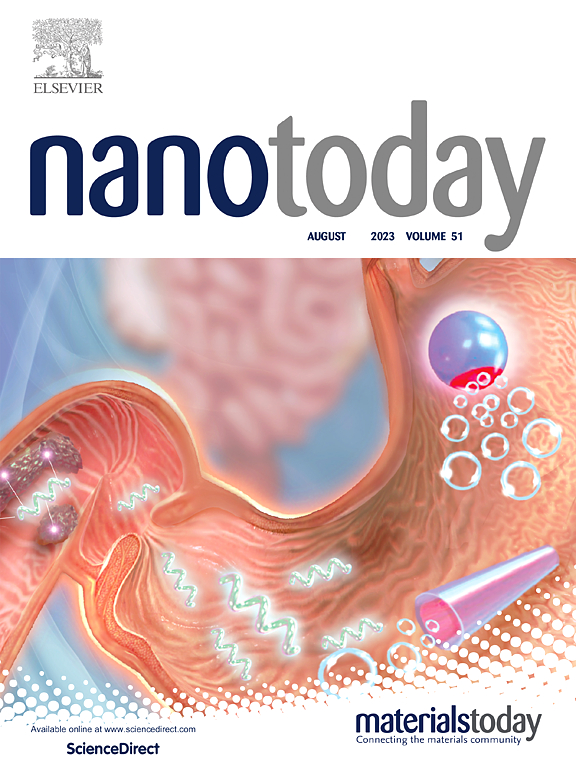j聚集的吲哚菁绿色负载外泌体能够光激活STING激动剂的细胞质递送,用于靶向胰腺癌免疫治疗
IF 13.2
1区 材料科学
Q1 CHEMISTRY, MULTIDISCIPLINARY
引用次数: 0
摘要
细胞内递送干扰素基因刺激剂(STING)激动剂对于靶向癌症治疗至关重要,同时最大限度地减少脱靶细胞因子风暴。在这项研究中,我们设计肿瘤细胞来源的外泌体作为细胞内递送STING激动剂的同型纳米载体,使肿瘤特异性的STING激活能够增强对胰腺癌的光免疫治疗,而不会产生全身毒性。为了实现STING激动剂的光控时空释放,我们将fda批准的光敏剂吲哚菁绿包封在受限的外泌体膜中,促进j聚集的形成,通过增加系统间交叉来增强单线态氧的产生。近红外光照射触发外泌体和溶酶体膜破裂,导致STING激动剂SR-717的光激活爆发释放和细胞质运输,从而在胰腺癌中引发肿瘤特异性的STING激活。这种STING激活诱导了强大的免疫反应,提高了免疫原性和抗原性,并完全抑制了脱靶毒性。这种方法在小鼠胰腺肿瘤模型中显示出强有力的治疗效果,导致长期免疫记忆。我们的研究结果为STING激动剂的递送提供了一种新的策略,提高了光激活免疫治疗难以治疗癌症的安全性和有效性。本文章由计算机程序翻译,如有差异,请以英文原文为准。
J-Aggregated indocyanine green-loaded exosomes enable photoactivatable cytoplasmic delivery of STING agonist for targeted pancreatic cancer immunotherapy
Intracellular delivery of stimulator of interferon genes (STING) agonist is crucial for targeted cancer therapy while minimizing off-target cytokine storms. In this study, we engineer tumor cell-derived exosomes as homotypic nanocarriers for the intracellular delivery of STING agonist, enabling tumor-specific STING activation to enhance photoimmunotherapy against pancreatic cancer without systemic toxicity. To enable photo-controlled spatiotemporal release of the STING agonist, we encapsulate FDA-approved photosensitizer indocyanine green in the confined exosomal membranes, facilitating J-aggregate formation to enhance the singlet oxygen generation via increased intersystem crossing. Near-infrared light irradiation triggers rupture of both exosomal and lysosomal membranes, resulting in photoactivatable burst release and cytoplasmic trafficking of STING agonist SR-717, which elicits the tumor-specific STING activation in pancreatic cancers. Such STING activation induces robust immune responses with elevated immunogenicity and antigenicity, and totally suppresses off-target toxicity. This approach demonstrates potent therapeutic efficacy in murine pancreatic tumor models, leading to long-term immunological memory. Our findings offer a novel strategy for STING agonist delivery, improving the safety and efficacy of photoactivatable immunotherapy for difficult-to-treat cancers.
求助全文
通过发布文献求助,成功后即可免费获取论文全文。
去求助
来源期刊

Nano Today
工程技术-材料科学:综合
CiteScore
21.50
自引率
3.40%
发文量
305
审稿时长
40 days
期刊介绍:
Nano Today is a journal dedicated to publishing influential and innovative work in the field of nanoscience and technology. It covers a wide range of subject areas including biomaterials, materials chemistry, materials science, chemistry, bioengineering, biochemistry, genetics and molecular biology, engineering, and nanotechnology. The journal considers articles that inform readers about the latest research, breakthroughs, and topical issues in these fields. It provides comprehensive coverage through a mixture of peer-reviewed articles, research news, and information on key developments. Nano Today is abstracted and indexed in Science Citation Index, Ei Compendex, Embase, Scopus, and INSPEC.
 求助内容:
求助内容: 应助结果提醒方式:
应助结果提醒方式:


